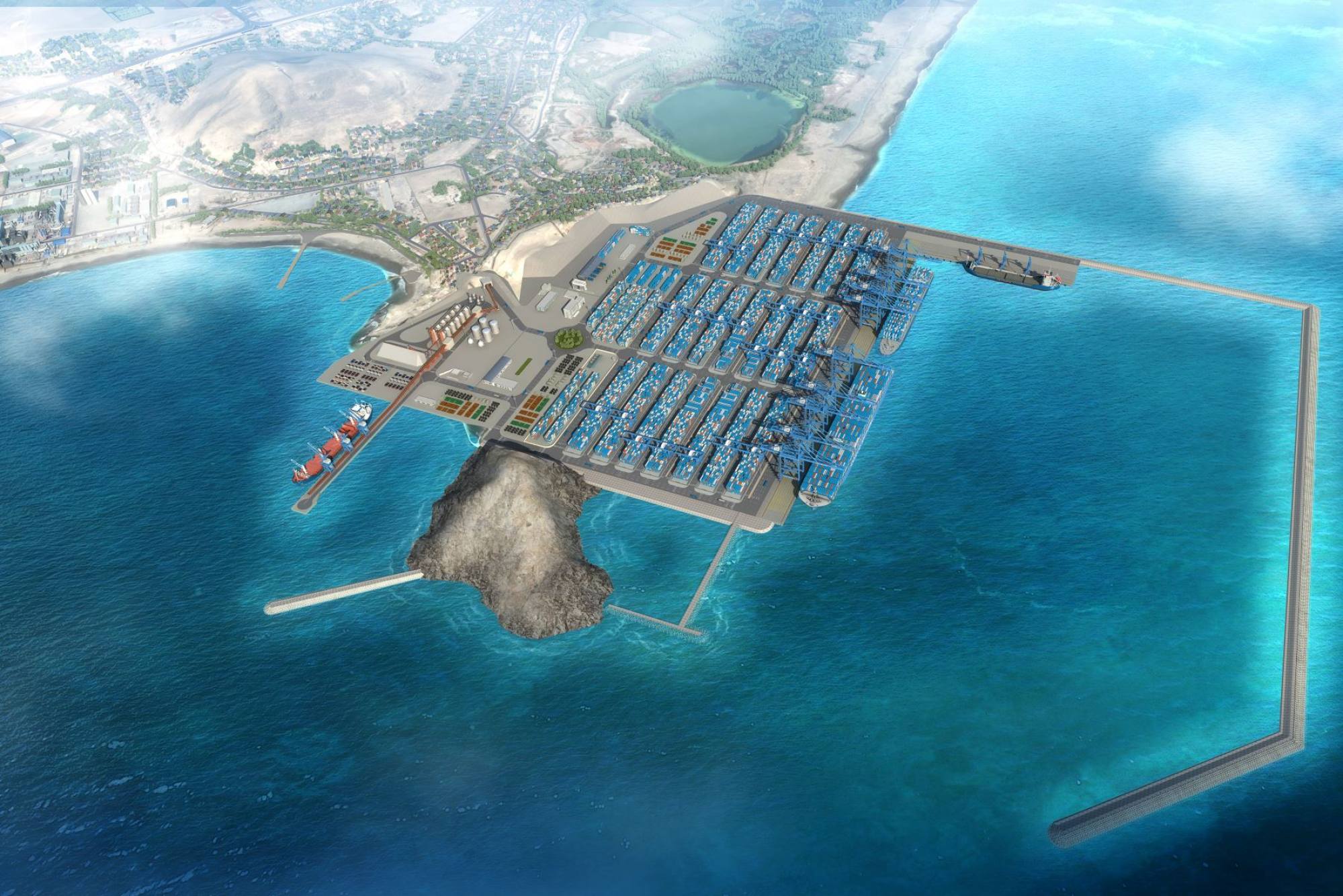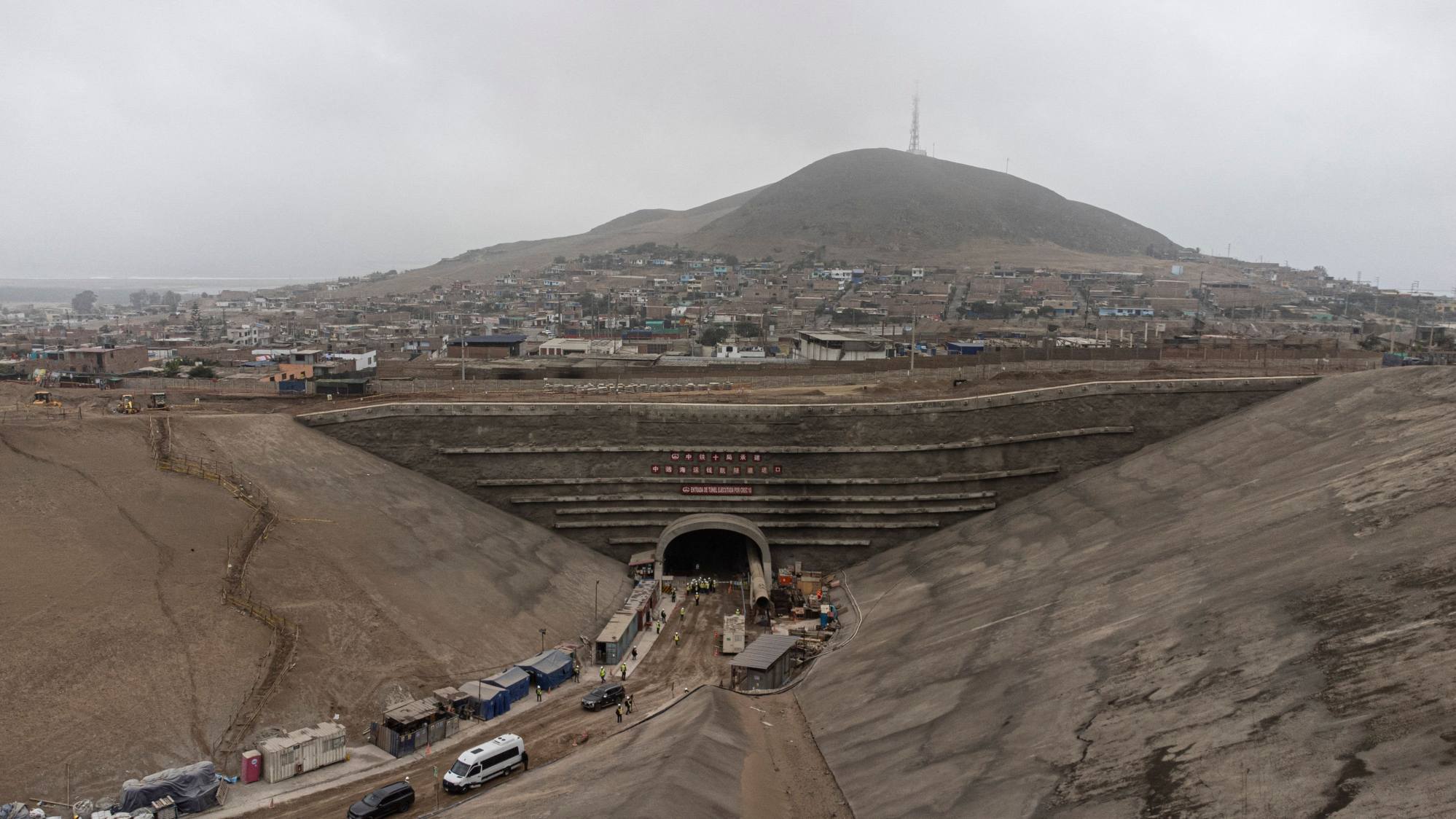
02:43
Gateway to Asia: China builds port in Peru for faster transport of goods to and from South America
Peru megaport to open new Pacific trade route to China. Will it be a win for all?
- Chinese-backed port in Peru aims to offer a faster, alternative route to China from South America
- Port of Chancay is part of China’s Belt and Road Initiative, which was launched a decade ago
A US$3 billion megaport in Peru seen as a new gateway to Asia is on track to open four of its 11 berths at the end of 2024, offering a faster Pacific Ocean route to China for sea cargo from this part of Latin America.
The project broke ground in 2011 in the small city of Chancay about 72km (44 miles) north of Lima, and with major help from Chinese investment.
It was designed to make Peru a global shipping hub, competing with Chile and Ecuador as a link between South America and East Asia.
Normally, the journey through the Panama Canal or from Cabo de Hornos in Chile takes up to 45 days. The Chancay megaport will cut that time down to 30 days by connecting land and sea routes from as far as the Atlantic coast to across the Pacific.

It appears to be an all around positive deal for both Peru and the primary investor, China, but some experts are focused on the economic long-term impacts of the mega infrastructure project, primarily which country will benefit most from it.
Lessons can be learned from other countries that have struck a port-building deal with China. Sri Lanka’s Hambantota port is a key example, which relied on Chinese loans in 2017 to build it.
Why fears of a Chinese naval base at Pakistan’s Gwadar port are overblown
Critics argued that Sri Lanka would fall into a debt trap, where it would struggle to repay these loans, leading to economic and political leverage for China. Peruvian experts have hopped on the discussion early to avoid the same result.
“China is winning because they have more markets. They’re more efficient and have more services with a shipping fleet. And yet, this is an opportunity for Chancay and Peruvian people to reach their dreams,” said Omar Narrea, a researcher at Universidad del Pacifico’s Centre of China and Asia-Pacific Studies (CECHAP) based in Lima.
China announced its Belt and Road Initiative nearly a decade ago in 2013. Since then, it has invested in ports, highways, trains and other infrastructure projects throughout the developing world. Only recently has Beijing turned its full attention to Latin America with its belt and road funding.
Latin America is well behind the recommended infrastructure spending goal set out by the World Bank, as much as six per cent of a country’s GDP.
Between 2009 and 2019, Latin American nations spent an average of less than two per cent of total GDP on public projects, like improving roads or building hospitals. China has seen this as an opportunity to make inroads in the region.
“There exists a huge infrastructural gap. From the Chinese perspective, it fits very well into the Belt and Road Initiative,” said Enrique Dussel Peters, an economist from Universidad Nacional Autonoma de Mexico (UNAM). “Meanwhile, the rest of the world, including the US, European Union and also the World Bank have not paid much attention to this topic, to this gap, not only in Latin America, but also in Africa and Asia.”

By 2010, after a decade of rapid Chinese growth, that number hit US$180 billion. In 2023, it hovered around US$450 billion, and some economists project it to exceed US$700 billion by 2035. All of that to say, Chinese-South American trade is growing at a staggering pace.
“These infrastructure projects are growing very quickly all over the region, particularly very recently in countries such as Chile, in Mexico and Peru,” Dussel Peters said.
In the case of the Chancay port, the spending gap is a void being filled by Chinese shipping giant Cosco, which holds a 60 per cent stake.
Sri Lankan port could be China’s top choice for next naval base: report
The remaining 40 per cent is funded by Peruvian mining company Volcan, which is mostly engaged in the extraction of silver, zinc, copper and lead. Not only does the Peruvian company have a smaller piece of the pie, but it likely will not see its mined goods exported out of the Chancay port, Narrea said.
“There are other mines in Peru that export minerals like copper and zinc, in Callao and ports south, which have special facilities for them. The Chancay port was originally supposed to be just mining, but when the Chinese arrived, they had a new purpose based on shipping large containers.”
Narrea explained that the idea for the Chancay port dates back long before Cosco was involved.
In the 1980s, local miners imagined building a port to ship their products up the Pacific coastline, but in the 2010s, a new global model for shipping emerged, led by Chinese technological advancements in manufacturing and export methods.
When Cosco threw its hat in the ring to own a majority of the Chancay port, the project and its potential grew bigger. It went from a local port to a global shipping hub, which Peru may not be prepared to handle.
“The Peruvian government lacks strategies to take advantage of this port hub, but we can learn from the Chinese approach. The shipping mode is now global and it’s changing. We need to take this project as an opportunity for Peru and Latin America to integrate into the shipping network,” Narrea said.
A team at Universidad del Pacifico in Lima has come up with strategies for integrating the nation into a larger, global trade network so that China, Peru, and greater South America will benefit from the Chancay port.
China and Russia pursue Eritrea for its strategic location in Africa
They also stress the importance of consulting local Chancay residents to avoid resistance later in the construction timeline.
“For us, it is not just about what Cosco and its corporate partners get out of this, but what Peruvian companies, professionals, workers, farmers, fishermen and others can get out of it, if there is decent planning on our end,” said Cynthia Sanborn, a political scientist and researcher at Universidad del Pacifico in Lima.
The territory within 510km (315 miles) of Chancay has been dubbed the “hinterland”, including regions of La Libertad, Ancash, Lima, Huanuco, Pasco, Junin, and part of San Martin, Loreto and Ucayali.
The hinterland is where Peru can strike gold, so to speak, with its lush resources and existing production chains. It is divided into corridors, with the first closest to the coast. It is rich in mining, particularly copper and iron ore, two of China’s biggest imports from Peru.
The second corridor is heavily forested and farmed, meaning timber and goods come out of it, like avocados, coffee and cacao.

The third includes the Pan-American Highway North, connecting Chancay to northern Peru, which is home to processing centres.
“The idea is to link this to an industrial park where goods from the hinterland can be processed or packaged and sent off to Asia more easily, so there are backward linkages, as well as receiving goods from Asia, and re-routing things to and from other countries as a major South American maritime hub,” said Sanborn, who added that the project would also impact Chancay, hopefully for the better.
“Chancay is a relatively small and depressed area. There is no other major economic or tourism activity there, so the potential for opportunities for locals is huge. From what we have seen, the company has been working with local authorities to develop such opportunities, ranging from scholarships and job training to investment in new income generating activities.”
Germany says controversial Chinese stake in Hamburg port to go ahead
Though, Sanborn and Narrea explained it is inevitable that locals will face disappointment from high expectations.
“We believe it’s very important to consider the development of the Chancay people. This is a natural moment to push for that,” Narrea said.
The first phase to be completed by the end of next year costs US$1.3 billion. Cosco, with its vast network of ports and shipping capabilities, has a major stake in what the company says will be the largest “gateway to Asia”.
If Peruvian officials play their cards right and fast, the people of Chancay and the hinterlands might prosper, too.

